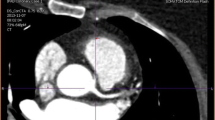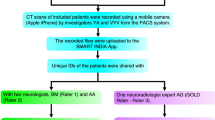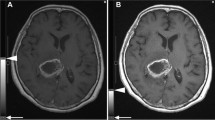Abstract
Purpose
The use of tablet terminals has been explored in various medical settings; however, caution should be exercised when performing image diagnosis using this technology. The present study examined the characteristics of an iPad Air™ monitor and assessed radiographic image interpretations to verify the reliability of the telediagnosis of acute cerebral infarction based on magnetic resonance imaging (MRI) using a tablet terminal.
Materials and methods
The luminance of the iPad Air™ was measured using a UA-10 analyzer, and radiographic image interpretation experiments were performed in 100 patients who underwent MRI within 6 h of symptom onset. Ten physicians viewed the images on the iPad Air™ and a medical monitor, with an interval of 2 months between each interpretation.
Results
When the iPad Air™ screen was pure white, the contour lines revealed nonuniform luminance distribution. In the reading experiment, the areas under the curve of the medical monitor and the iPad Air™ were 0.9311 and 0.9431, respectively. No significant difference was observed between the medical monitor and the iPad Air™ (p = 0.113).
Conclusion
The results of the observer performance studies for detecting acute ischemic cerebrovascular disorders on an iPad Air™ were found to be similar to those on a medical monitor.






Similar content being viewed by others
References
Turney BW, Reynard JM. Obtaining patient feedback in an outpatient lithotripsy service is facilitated by use of a touch-screen tablet (iPad™) survey. Urolithiasis. 2014;42(4):317–21.
Maruyama K, Kin T, Saito T, Suematsu S, Gomyo M, Noguchi A, et al. Neurosurgical simulation by interactive computer graphics on iPad. Int J Comput Assist Radiol Surg. 2014;9(6):1073–8.
Chao C, Tan J, Castillo EM, Zawaideh M, Roberts AC, Kinney TB. Comparative efficacy of new interfaces for intra-procedural imaging review: the Microsoft Kinect, Hillcrest Labs Loop Pointer, and the Apple iPad. J Digit Imaging. 2014;27(4):463–9.
Johnson PT, Zimmerman SL, Heath D, Eng J, Horton KM, Scott WW, et al. The iPad as a mobile device for CT display and interpretation: diagnostic accuracy for identification of pulmonary embolism. Emerg Radiol. 2012;19(4):323–7.
Eguchi T, Takasuna K, Kitazawa A, Fukuzawa Y, Sakaue Y, Yoshida K, et al. Three-dimensional imaging navigation during a lung segmentectomy using an iPad. Eur J Cardiothorac Surg. 2012;41(4):893–7.
McNulty JP, Ryan JT, Evanoff MG, Rainford LA. Flexible image evaluation: iPad versus secondary-class monitors for review of MR spinal emergency cases, a comparative study. Acad Radiol. 2012;19(8):1023–8.
Norweck JT, Seibert JA, Andriole KP, Clunie DA, Curran BH, Flynn MJ, et al. ACR-AAPM-SIIM technical standard for electronic practice of medical imaging. J Digit Imaging. 2013;26(1):38–52.
Japan Radiological Society. Guidelines for the handling of digital images, version 3.0. 2015. http://www.radiology.jp/content/files/20150417.pdf. Accessed 5 May 2018.
JIRA. quality assurance (QA) guideline for medical imaging display systems. 2017. http://www.jira-net.or.jp/publishing/files/jesra/JESRA_X-0093B_2017.pdf. Accessed 5 May 2018.
National Electrical Manufacturers Association. Digital imaging and communications in medicine (DICOM). Part 14. Grayscale standard display function. http://medical.nema.org/Dicom/2011/11_14pu.pdf. Accessed 5 May 2018.
BARCO. MediCal QAWeb Mobile. https://www.barco.com/en/Products/Software/Medical-calibration-and-QA-software/Visual-calibration-and-QA-for-your-tablet.aspx/. Accessed 5 May 2018.
EIZO. RadiCS. http://www.eizoglobal.com/press/releases/htmls/radicsmobile.html. Accessed 5 May 2018.
Yoshimura K, Shimamoto K, Ikeda M, Ichikawa K, Naganawa S. A comparative contrast perception phantom image of brain CT study between high-grade and low-grade liquid crystal displays (LCDs) in electronic medical charts. Phys Med. 2011;27(2):109–16.
Yoshimura K, Nihashi T, Ikeda M, Ando Y, Kawai H, Kawakami K, et al. Comparison of liquid crystal display monitors calibrated with gray-scale standard display function and with γ 2.2 and iPad: observer performance in detection of cerebral infarction on brain CT. AJR. 2013;200(6):1304–9.
Hattori H, Shinpei A, Yoshitaka I, Toyama H. Consideration of reliability in the diagnosis of acute ischemic cerebrovascular disorders about MRI in iPad air. In: EPOS of the ECR, 2016. https://doi.org/10.1594/ecr2016/C-1280.
Kobayashi T, Xu XW, MacMahon H, Metz CE, Doi K. Effect of a computer-aided diagnosis scheme on radiologists’ performance in detection of lung nodules on radiographs. Radiology. 1996;199(3):843–8.
Kanda Y. Investigation of the freely available easy-to-use software ‘EZR’ for medical statistics. Bone Marrow Transplant. 2013;48(3):452–8.
John S, Poh AC, Lim TC, Chan EH, le Chong R. The iPad tablet computer for mobile on-call radiology diagnosis? Auditing discrepancy in CT and MRI reporting. J Digit Imaging. 2012;25(5):628–34.
Park JB, Choi HJ, Lee JH, Kang BS. An assessment of the iPad 2 as a CT teleradiology tool using brain CT with subtle intracranial hemorrhage under conventional illumination. J Digit Imaging. 2013;26(4):683–90.
Caffery LJ, Armfield NR, Smith AC. Radiological interpretation of images displayed on tablet computers: a systematic review. Br J Radiol. 1050;2015(88):20150191.
Caffery LJ, Manthey KL, Sim LH. The effect of time in use on the display performance of the iPad. Br J Radiol. 1063;2016(89):20150657.
RealVision. FVT-air. https://realvision.co.jp/service/fvt_air/. Accessed 5 May 2018.
Randhawa PA, Morrish W, Lysack JT, Hu W, Goyal M, Hill MD. Neuroradiology using secure mobile device review. Can J Neurol Sci. 2016;43(4):529–32.
Acknowledgements
The authors would like to express our gratitude to Kumiko Yoshimura of Nagoya University for her cooperation in the preparatory stage of this study, the doctors from the Department of Radiology, the Department of Neurosurgery and the Department of Neurology of Fujita Health University for their cooperation in the reading experiment, and Masao Ohashi, a radiological technologist in the Department of Radiology at Fujita Health University Hospital, for his cooperation with luminance measurement on the monitors. Special thanks also go to Dr. Shinpei Akiyama of Kyoto Prefectural University of Medicine, Department of Radiology, and Dr. Nobuo Kako of the AICHI Clinic of Healthcare.
This study was announced at the 74th Annual Meeting of the Japan Radiological Society (Yokohama city, Kanagawa prefecture, Pacifico Yokohama, April 16–19, 2015) and the ECR https://doi.org/10.1594/ecr2016/C-1280.
This work was supported by JSPS KAKENHI Grant-in-Aid for Young Scientists (B) 26860407.
This study was approved in advance by the Institutional Review Board of Fujita Health University (Toyoake, Aichi, Japan).
Author information
Authors and Affiliations
Corresponding author
Ethics declarations
Conflict of interest
The author has no conflict of interest to disclose with respect to this article.
About this article
Cite this article
Hattori, H., Kuwayama, Y., Inui, Y. et al. Reliability of diagnosing acute ischemic cerebrovascular on magnetic resonance imaging disorders using iPads. Jpn J Radiol 36, 726–735 (2018). https://doi.org/10.1007/s11604-018-0763-y
Received:
Accepted:
Published:
Issue Date:
DOI: https://doi.org/10.1007/s11604-018-0763-y




